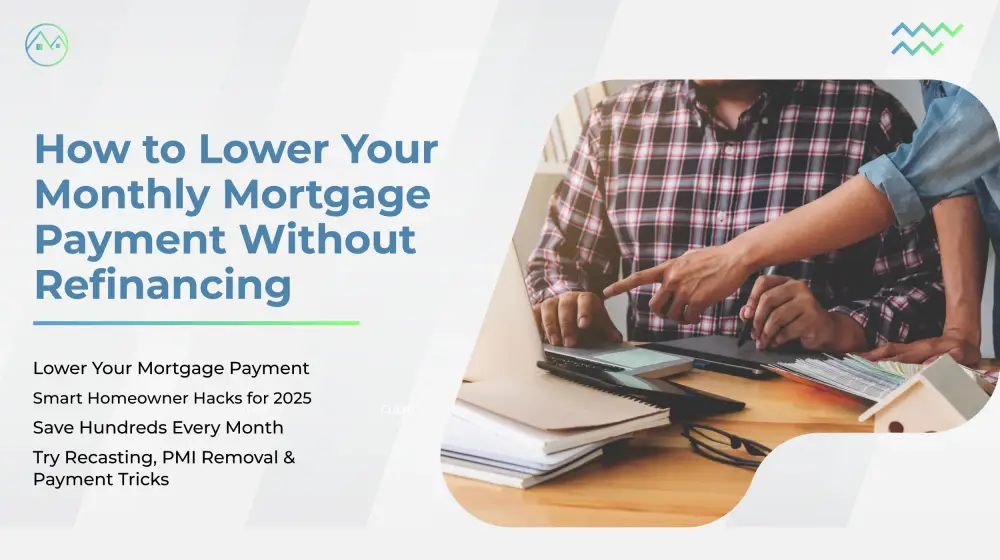
How to Lower Your Monthly Mortgage Payment Without Refinancing
Let’s face it refinancing sounds exhausting. The paperwork, credit checks, and closing costs can make homeowners hesitate, even when monthly payments feel heavy.
In 2025, many Americans are searching for smarter ways to reduce their mortgage payments without refinancing. Whether it’s due to rising living expenses, inflation, or just a desire for more financial breathing room, the good news is there are lender-approved strategies that actually work.
In this guide, we’ll explore five proven ways to lower your mortgage payment without refinancing including real homeowner experiences and step-by-step examples you can apply right away.
Why You Might Want to Lower Your Payment
Lowering your monthly payment can ease financial stress, free up savings, or help you stay ahead during economic uncertainty. Some common reasons homeowners in 2025 are exploring payment reduction include:
-
Rising living costs and tighter household budgets.
-
Interest rates that make refinancing less appealing.
-
Unexpected income changes or job transitions.
-
Desire for improved cash flow and financial flexibility.
As one homeowner told me recently, “It’s not that I can’t pay it’s that I don’t want to overpay when there are smarter options.”
So, let’s dive into those smarter options. Check out mortgage approval tips.
Option #1: Mortgage Recasting — The Hidden Gem
What Is a Mortgage Recast?
A mortgage recast lets you make a lump-sum payment toward your loan’s principal. Then your lender recalculates your monthly payment based on the new, smaller balance but keeps your interest rate and term the same.
This option is perfect if you recently came into extra funds (like a bonus, inheritance, or home sale proceeds).
Why It Works
-
Lowers your monthly payment immediately.
-
No new loan, no appraisal, no underwriting.
-
Small administrative fee (usually $150–$300).
-
Doesn’t reset your loan term.
Example
Let’s say you owe $300,000 on a 30-year mortgage at 6%. You pay a $30,000 lump sum to recast. Your new balance becomes $270,000, and your monthly payment drops by about $180–$200 per month permanently.
Real Experience
Last year, one of my clients, David, used his year-end bonus to recast his conventional loan. He avoided a refinance and shaved $210 off his monthly payment. “Best financial move I made all year,” he said.
📘 Want to learn more about smart strategies like this? Check out Mortgage Market 2025: Lower Rates, Higher Hurdles for Buyers.
Option #2: Remove PMI (Private Mortgage Insurance)
If your down payment was under 20%, you’re probably paying PMI. It protects the lender not you but once your loan-to-value (LTV) ratio drops below 80%, you can request to remove it.
How to Remove PMI in 2025
-
Check your current LTV ratio through your lender.
-
If your property value increased, order a new appraisal.
-
Submit a formal PMI removal request.
Potential Savings
Canceling PMI can save you $1,000–$2,500 annually, depending on your loan amount.
Pro Tip
Some homeowners reach 80% LTV faster by applying small extra payments toward their principal each month.
For a detailed breakdown of how different loan types handle PMI and related fees, read How to Use an FHA Loan to Buy Your First Home.
Option #3: Adjust Your Property Taxes or Escrow
Your monthly mortgage payment includes escrow, which covers property taxes and homeowners insurance. If your home’s tax value is assessed too high, you’re likely paying more than necessary.
Steps to Reduce Property Tax or Escrow
-
Review your property tax assessment look for inaccurate valuations.
-
File an appeal with your county assessor (usually online).
-
Ask your lender for an escrow review if payments seem inflated.
Example
A homeowner in Texas recently discovered her property was overvalued by $35,000. After filing a reassessment, her taxes dropped saving $120/month on her mortgage payment.
Tip
Even if your appeal doesn’t succeed, verifying your escrow helps ensure your lender isn’t over-collecting funds.
Option #4: Try a Biweekly Payment Strategy
The biweekly payment method is a lesser known trick that can help reduce interest and pay off your loan faster without refinancing.
How It Works
-
Instead of one full monthly payment, you make half-payments every two weeks.
-
This results in 26 half-payments (13 full payments) per year one extra payment annually.
Benefits
-
Lowers total interest paid.
-
Helps you build equity faster.
-
Reduces your loan term by years without extra paperwork.
You can set this up through your lender or manually via your online payment portal.
📈 For more rate insights, see Will Mortgage Rates Drop in 2025? Expert Predictions & Insights.
Option #5: Ask About Loan Modification Programs
If your income has dropped or expenses have increased, a loan modification could be the right path.
How It Works
A loan modification adjusts your loan’s interest rate, term, or payment structure to make it more affordable without replacing the loan.
Types of Modifications
-
Term Extension: Extends your repayment period.
-
Rate Reduction: Lowers your interest rate temporarily or permanently.
-
Principal Forbearance: Defers a portion of your balance until later.
These programs are especially helpful during hardship situations.
If you’re unsure whether you qualify, connect with a trusted mortgage advisor or explore flexible options like FHA Loans and VA Loans.
Bonus Tips: Small Habits That Make a Big Difference
-
Apply tax refunds or bonuses to your principal. Even small lump sums help reduce future interest.
-
Remove escrow (if eligible) and manage property taxes yourself for more control.
-
Avoid late fees. Even one missed payment can affect your escrow or credit.
-
Round up your payments. Paying $50–$100 extra monthly can knock off years from your loan.
Real Experience: How One Couple Saved $250/Month
In early 2025, I worked with James and Laura, a couple from Illinois who felt stuck — their mortgage rate was locked high from 2022, and refinancing made no sense due to fees.
We explored mortgage recasting and PMI removal instead. They applied a $20,000 lump sum toward their principal and ordered a new appraisal that showed increased equity.
Within six weeks, their payment dropped $250/month, without touching their loan term or interest rate.
“I thought saving that much meant refinancing,” Laura said. “Turns out, just knowing the right questions to ask made all the difference.”
That’s the beauty of understanding your mortgage flexibility and why working with professionals who know these options is so valuable.
Conclusion: Lower Payments Without the Hassle
Refinancing isn’t your only path to financial relief. In 2025, smart homeowners are using recasting, PMI removal, escrow adjustments, and payment strategies to make their mortgages more manageable.
Remember your lender wants to keep you on track, not see you struggle. Don’t hesitate to ask about these options and review your statement regularly.
👉 Ready to explore non-refinance strategies that actually save you money? Schedule a Demo with InkMortgage today and get personalized help lowering your mortgage payment fast.
